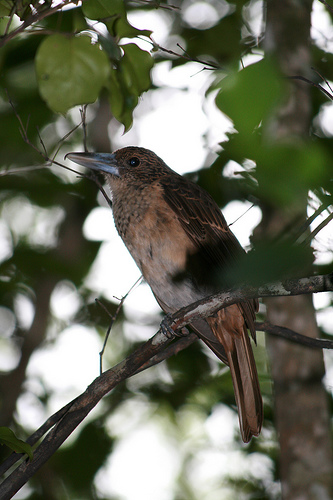Alternative names: Spalding Butcherbird; Rufous Butcherbird; Brown Butcherbird; Quoy Butcherbird; Black Crow-Shrike; Rufous Crow-Shrike
- Melloria quoyi
Cracticus quoyi
Identification
33 - 44cm. A large, all-dark butcherbird with a massive-hook-tipped bill:
- Black plumage, brighter glossy blue-back on back
- Long tail, rounded in flight but appears square-tipped when resting
- Brown eye
- Blue-grey or milky blue bill, distal third black
- Dark grey or black legs
Sexes similar.
Juveniles have dull black or brownish-black underparts, a yellowish-brown iris, a pale grey bill and dark grey legs. Juveniles and immatures of rufescens occur in two morphs, the normal black one and a rufous one. This rufous morph is not found in any other subspecies.
Distribution

Photo by butcherbird
Conway National Park, Proserpine region, Queensland
Found in New Guinea and adjacent Papuan Islands and northern Australia.
Common and widespread in its range.
Taxonomy
Formerly placed in genus Cracticus.
Subspecies[1]
There are 5 subspecies:
- M. q. quoyi:
- New Guinea, Yapen Island and western Papuan islands
- M. q. spaldingi:
- Aru Islands; Western Australia to Arnhem Land and adjacent islands
- M. q. alecto:
- Islands of North Torres Strait (Boigu and Saibai)
- M. q. jardini
- Coasts of western and eastern Cape York Peninsula south to Cooktown
- M. q. rufescens:
- Eastern Queensland (Cairns to about Sarina)
Habitat
Mainly mangrove forest in Australia, most forest types and plantations in New Guinea. From the lowlands up to 1300m.
Behaviour
A sedentary species.
Diet
Feeds mainly on insects but takes also small vertebrates like small lizards, small snakes, frogs, small mammals, birds and their nestlings, small crab and fish. Forages mostly in the lower canopy and sub-canopy, sometimes on the ground, also searching litter. Large prey items are wedged into a crack or fork or impaled on a spike and then dismembered.
Breeding
Little known about breeding. Laying mainly from September to October in New Guinea, October to November in Australia. The nest is an untidy bowl made of sticks and twigs, placed 5 - 15m above the ground in a tree fork. Lays 2 - 4 eggs. In Northeast Australia Trumpet Manucode breeds often near this species, obviously benefiting from its aggressive nest defence.
References
- Clements, J. F., P. C. Rasmussen, T. S. Schulenberg, M. J. Iliff, T. A. Fredericks, J. A. Gerbracht, D. Lepage, A. Spencer, S. M. Billerman, B. L. Sullivan, and C. L. Wood. 2023. The eBird/Clements checklist of Birds of the World: v2023. Downloaded from https://www.birds.cornell.edu/clementschecklist/download/
- Gill, F, D Donsker, and P Rasmussen (Eds). 2024. IOC World Bird List (v 14.2). Doi 10.14344/IOC.ML.14.2. http://www.worldbirdnames.org/
- Del Hoyo, J, A Elliott, and D Christie, eds. 2009. Handbook of the Birds of the World. Volume 14: Bush-shrikes to Old World Sparrows. Barcelona: Lynx Edicions. ISBN 978-8496553507
- Avibase
- Birdforum Member observations
Recommended Citation
- BirdForum Opus contributors. (2025) Black Butcherbird. In: BirdForum, the forum for wild birds and birding. Retrieved 30 April 2025 from https://www.birdforum.net/opus/Black_Butcherbird
External Links
GSearch checked for 2020 platform.1





